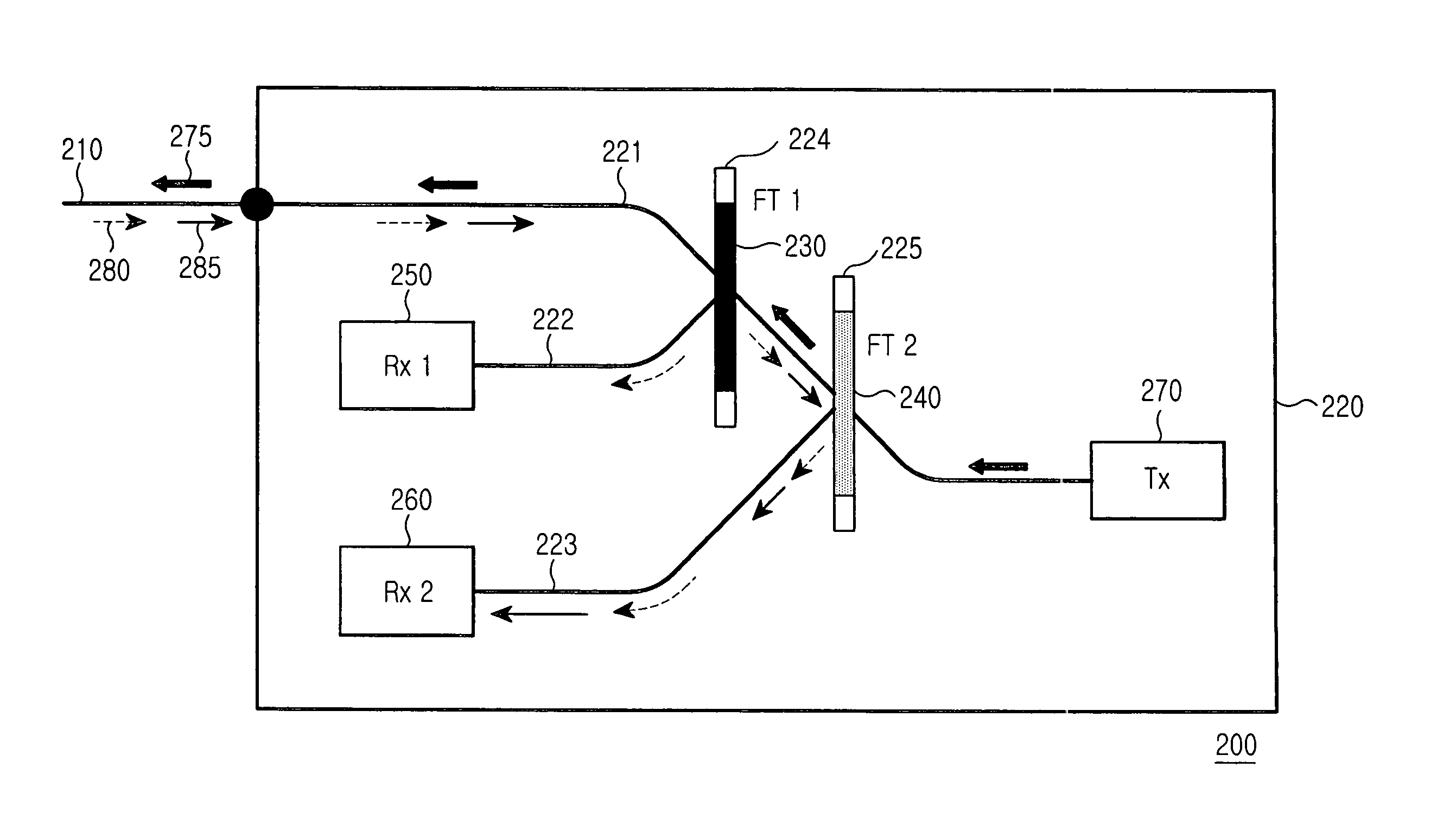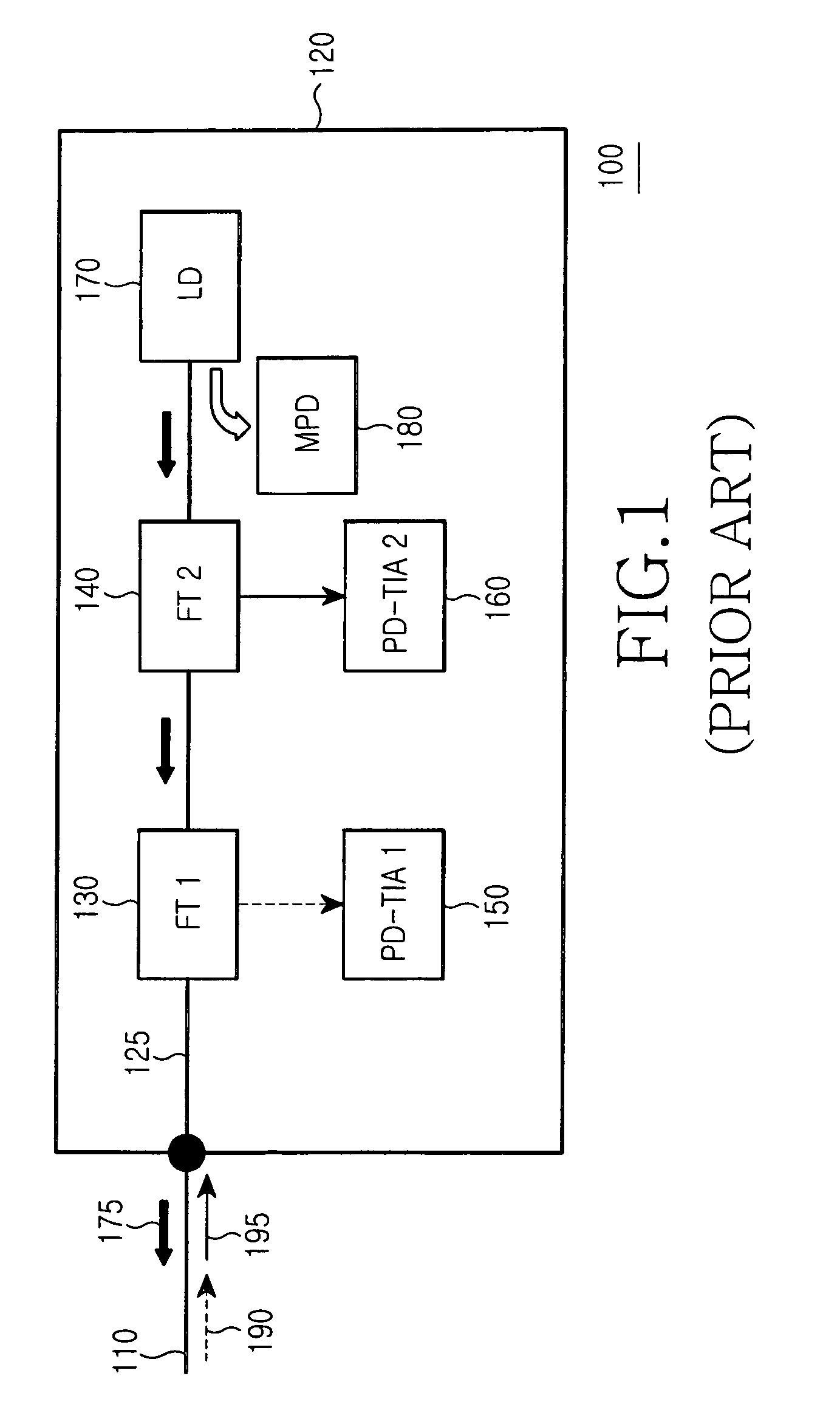Bidirectional optical triplexer
a bidirectional optical and triplexer technology, applied in multiplex communication, electromagnetic repeaters, instruments, etc., can solve the problems of reducing affecting the performance of the system, so as to reduce the crosstalk between elements and reduce the size of the platform
- Summary
- Abstract
- Description
- Claims
- Application Information
AI Technical Summary
Benefits of technology
Problems solved by technology
Method used
Image
Examples
first embodiment
[0032]FIG. 2 is a diagram showing a bidirectional optical triplexer 200 according to the present invention. The optical triplexer 200 includes a platform 220, first and second filters 230 and 240, first and second optical receivers (Rxs) 250 and 260, and an optical transmitter 270. The optical triplexer 200 can be connected to an external optical waveguide 210. Also, the optical triplexer 200 can receive a first optical signal 280, which may be an analog video signal having about a 1550 nm wavelength, and a second optical signal 285, which may be a digital data signal having about a 1490 nm wavelength, through the external optical waveguide 210. In addition, the optical triplexer 200 transmits a third optical signal 275, which may be a digital data signal having about a 1310 nm wavelength, through the external optical waveguide 210.
[0033]The platform 220 includes a first optical path 221, which can be optically connected with the external optical waveguide 210, first and second tren...
second embodiment
[0044]FIG. 3 is a diagram showing a bidirectional optical triplexer 300 according to the present invention.
[0045]Referring to FIG. 3, the optical triplexer 300 includes a platform 320 which has first to third optical paths 321 to 323 and first and second trenches 324 and 325, first to third filters 330 to 350, first and second optical receivers 360 and 370, and an optical transmitter 380. When comparing the structure of the optical triplexer 300 with the structure shown in FIG. 2, there is one difference in that the optical triplexer 300 additionally has a third filter 350. Therefore, redundant descriptions will be omitted.
[0046]The platform 320 includes the first optical path 321, which may be optically connected with an external optical waveguide 310, first and second trenches 324 and 325, which are spaced from each other on the first optical path 321, the second optical path 322, which extends from the first trench 324, and a third optical path 323, which extends from the second ...
third embodiment
[0049]FIG. 4 is a diagram showing a bidirectional optical triplexer 400 according to the present invention. FIG. 5a is a graph representing the reflection characteristic of the second filter 440. The optical triplexer 400 includes a platform 420 which has first to third optical paths 421 to 423 and first and second trenches 424 and 425, first to second filters 430 to 440, first and second optical receivers 450 and 460, and an optical transmitter 470. When comparing the structure of the optical triplexer 400 with the structure shown in FIG. 2, the optical triplexer 400 has only one difference in that the optical triplexer 400 uses the second filter 440 having different characteristic from that of the structure shown in FIG. 2. Therefore, redundant descriptions will be omitted.
[0050]The second filter 440 is positioned in the second trench 425. The second filter 440 reflects the second optical signal 485 proceeding through the first optical path 421. In addition, the second filter 440 ...
PUM
 Login to View More
Login to View More Abstract
Description
Claims
Application Information
 Login to View More
Login to View More - R&D
- Intellectual Property
- Life Sciences
- Materials
- Tech Scout
- Unparalleled Data Quality
- Higher Quality Content
- 60% Fewer Hallucinations
Browse by: Latest US Patents, China's latest patents, Technical Efficacy Thesaurus, Application Domain, Technology Topic, Popular Technical Reports.
© 2025 PatSnap. All rights reserved.Legal|Privacy policy|Modern Slavery Act Transparency Statement|Sitemap|About US| Contact US: help@patsnap.com



